battle
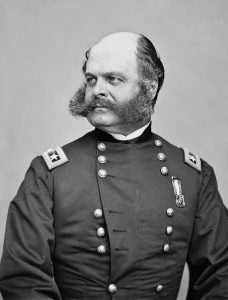 Those who have studied the Civil War, or know much about the United States at all, know that the Civil War was won by the Union, but that does not mean that there weren’t battles that they lost. There are very few wars that are lopsided in their battle field victories. One such battle was the Battle of Fredericksburg. On December 11, 1862, Ambrose Burnside, newly placed in command of the Army of the Potomac, planned to cross the Rappahannock River in Virginia with over 120,000 troops. When he finally crossed it, two days later, on December 13, 1862, he confronted 80,000 troops of Robert E Lee’s Confederate Army at Fredericksburg. With 200,000 combatants, this was the largest concentration of troops of any Civil War Battle. It was also one of the battles the Union Army would lose. In a crushing defeat, the Union Army suffered nearly 13,000 casualties, while the Confederate Army only lost 5,000.
Those who have studied the Civil War, or know much about the United States at all, know that the Civil War was won by the Union, but that does not mean that there weren’t battles that they lost. There are very few wars that are lopsided in their battle field victories. One such battle was the Battle of Fredericksburg. On December 11, 1862, Ambrose Burnside, newly placed in command of the Army of the Potomac, planned to cross the Rappahannock River in Virginia with over 120,000 troops. When he finally crossed it, two days later, on December 13, 1862, he confronted 80,000 troops of Robert E Lee’s Confederate Army at Fredericksburg. With 200,000 combatants, this was the largest concentration of troops of any Civil War Battle. It was also one of the battles the Union Army would lose. In a crushing defeat, the Union Army suffered nearly 13,000 casualties, while the Confederate Army only lost 5,000.
People might think that Burnside was not much of a commander, but it should be mentioned that this was the first time he had commanded an army. He was a graduate of West Point, had risen quickly up the ranks, and had seen action in several battles prior to this fateful day. Abraham Lincoln had approached him about taking control of the Union’s Army. He hesitated, partly out of loyalty to the current commander and former classmate, and partly because he was unsure of his own ability. In the end the prior commander’s failure assured that he was on the way out, and rather than have Major General Joseph Hooker, a fierce rival, pass him up, Burnside accepted the commission on November 7, 1862.
Knowing that he had to have the element of surprise, Burnside came up with a plan to confront Lee’s Army of Northern Virginia at Fredericksburg. He planned to move his forces to the banks of the neighboring Rappahannock River, and then transport his men across by way of hastily assembled pontoon bridges, and surprise the enemy. Lincoln was impressed with the audacity of the plan and approved it, but expressed doubts about its potential for success. Burnside swung into action, reaching the banks of the Rappahannock by November 19, 1862. We will never know if the plan might have succeeded, if some Union generals, including Winfield Scott Hancock, who believed the river could be crossed without the boats, had sent the boats…but instead, they urged Burnside to act without them. Burnside, who believed the river was too swift and deep, refused. They waited a week for the boats…unfortunately, under the watchful eyes of the Confederate scouts.
The element of surprise was gone. When they finally began building the pontoon bridges, the Confederate Army opened fire. Burnside began a massive bombardment of Fredericksburg, in the first shelling of a city in the Civil War. They were able to hold back the Confederate Army long enough to finish the bridges, and then they rushed across the river. Two days later, Burnside ordered his left flank to attack Lee’s right, in the hopes that Lee would have to divert forces to the south of the city, leaving the center and Marye’s Heights vulnerable. For a few hours, it looked like this might actually work. General George Meade broke through “Stonewell” Jackson’s line, but the Union failed to send in enough reinforcements to prevent a successful Confederate counterattack. Lee was able to keep James Longstreet’s men in position at Marye’s Heights, where they decimated Union forces. Burnside lost eight men for every Confederate soldier lost there. Though Burnside briefly considered another assault, the battle was over. The Union had suffered nearly 13,000 casualties while the Confederates lost fewer than 5,000. They needed to regroup before attacking again.
Burnside was an unpopular commander, partly I’m sure, because he felt the need to rush into things without really planning them out. His feelings of inadequacy proved to be his downfall. As he was planning his next attack, some of his leaders went to President Lincoln to voice their concerns. In the end, Lincoln halted the attack. On January 20, 1983, Burnside was ready to go again, but again the pontoon bridges were delayed. The weather didn’t help things either. What had been a dry January turned rainy, and the roads were all but impassible. Troops that had covered 40 miles a day on their way to Fredericksburg now struggled to get further than a mile. For three days, Burnside’s troops continued their disastrous slog on what would become known as the “Mud March,” accompanied most of the way by jeering Confederate forces taunting them from dry land. Five days after his offensive began, it was over…and so was Burnside’s brief, six week stint as commander of the Army of the Potomac. Lincoln immediately removed him from command, replacing him with the very person he feared it would be…Joseph Hooker.
Fredericksburg was the low point in the war for the North, but the South was ecstatic. Burnside probably should have stuck to his side career…weaponry design. And that was what he went back to. He retired in 1853 and in 1856 received his first patent for a .54 caliber breech loading firearm. Impressed with the carbine’s performance, the U.S. Army awarded the Bristol Firearm Company in Rhode Island…where Burnside worked…with a $100,000 contract. The order was soon rescinded, however, under shady circumstances. It’s believed that a rival munitions company bribed the army ordinance department to switch suppliers. Burnside’s bad luck continued the next year when a failed bid for a Congressional seat, followed closely by a fire that destroyed the Bristol factory, forced the financially strapped Burnside to sell his patents. Others would reap the rewards  when, at the start of the Civil War, demand for his creation soared. By 1865, more than 55,000 carbines had been ordered, and the Burnside had become one of the most popular Union weapons of the war, second only to the Sharp carbine and my ancestor, Christopher Spencer’s Spencer carbine.
when, at the start of the Civil War, demand for his creation soared. By 1865, more than 55,000 carbines had been ordered, and the Burnside had become one of the most popular Union weapons of the war, second only to the Sharp carbine and my ancestor, Christopher Spencer’s Spencer carbine.
Burnside would eventually have a claim to fame, but it would not be for war or weapons. Burnside liked to wear his facial hair in what was an unusual way for the times. He had a bushy beard and moustache along with a clean-shaven chin. These distinctive whiskers were originally dubbed “burnsides,” but later the term would be altered and would become “sideburns.”
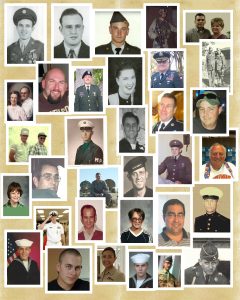 In times of war, and even in times of peace, there is a group of people who stand always at the ready…prepared to go at a moments notice, into battle to defend this country and the freedoms we enjoy. They are not always treated in the way they should be treated. It’s incomprehensible to me that we can ask these men and women to protect us in times of trouble, and then protest them when we don’t like the war they have been asked to fight. Today is Veterans Day. It is a day in which to honor all who served, in all wars, whether they were killed in action, died later, are retired or discharged from service, or are currently serving. So many veterans have served this country over the years. Without our soldiers, we would not be a free nation. In fact, were it not for our soldiers, we would probably still belong to England, or worse.
In times of war, and even in times of peace, there is a group of people who stand always at the ready…prepared to go at a moments notice, into battle to defend this country and the freedoms we enjoy. They are not always treated in the way they should be treated. It’s incomprehensible to me that we can ask these men and women to protect us in times of trouble, and then protest them when we don’t like the war they have been asked to fight. Today is Veterans Day. It is a day in which to honor all who served, in all wars, whether they were killed in action, died later, are retired or discharged from service, or are currently serving. So many veterans have served this country over the years. Without our soldiers, we would not be a free nation. In fact, were it not for our soldiers, we would probably still belong to England, or worse.
Our soldiers sacrifice everyday. In a post my nephew, Steve Spethman posted today, was a good explanation of just what a veteran really is, and I liked it. The saying went like this, “What is a veteran? A ‘Veteran’ – whether active duty, discharged, retired, or reserved – is someone who, at one point in his life, wrote a blank check made payable to ‘The United States of America,’ for an amount of ‘up to, and including his life.’ That is honor. And there are way too many people in this country today, who no longer understand that fact.” That really says it all. We think about our soldiers going into war, and fighting the  enemy. We even think about them losing their lives. We think about their loved ones back home worrying and praying for their safe return every day. We think about the irony and sometimes stupidity of war, and wonder why we can’t all just get along. People protest the wars, screaming at the soldiers because they did their duty and fought the war as they were ordered to do.
enemy. We even think about them losing their lives. We think about their loved ones back home worrying and praying for their safe return every day. We think about the irony and sometimes stupidity of war, and wonder why we can’t all just get along. People protest the wars, screaming at the soldiers because they did their duty and fought the war as they were ordered to do.
We think about and do so many things concerning war, but just how often to we really thing about the honor and integrity of the men and women who actually go into war, or even stand at the ready, just in case we need them. They know that every time they deploy with their unit, that it could easily end up being the last time they see their family, friends, or their country. They put their lives on hold, missing out on their children’s sporting events, school plays, holidays, birthdays, and even their birth, all to go out and put their lives on the line for people they don’t even know. Now, that’s honor!! Happy Veterans Day to all our veterans, and thank you all for your service. This nation and all it’s people owe you a debt of gratitude that we can never repay. We honor you today. God bless you all.
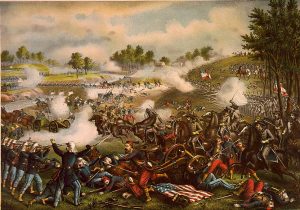 People don’t think of war as being something they want to send their children into…much less witness one themselves, or even one battle of a war. War really isn’t a spectator sport, after all. Nevertheless, there was a time, when people didn’t really seem to realize that. Early in the Civil War, the Union military command believed that the Confederate army could be easily defeated, and that the war would be over very quickly and with very little loss of life.
People don’t think of war as being something they want to send their children into…much less witness one themselves, or even one battle of a war. War really isn’t a spectator sport, after all. Nevertheless, there was a time, when people didn’t really seem to realize that. Early in the Civil War, the Union military command believed that the Confederate army could be easily defeated, and that the war would be over very quickly and with very little loss of life.
In July of 1861, the folly of that overconfidence was sharply pointed out when General Irvin McDowell led a premature offensive into northern Virginia. He set out in search of the Confederate forces, leading 34,000 mostly inexperienced troops, who were also poorly trained, toward the railroad junction of Manassas, which is just 30 miles from Washington DC. General Beauregard of the Confederate forces, was alerted of the advance, and so brought together 20,000 troops there. He was soon joined by General Joseph Johnston, who brought 9,000 additional men by way of railroad.
On the morning of July 21, 1861, the people of the area heard of the opposing forces, and that a battle was about to break out in their vicinity. Hundreds of civilian men, women, and children turned up to watch the first major battle of the Civil War. The fighting commenced with three Union divisions crossing the Bull Run stream. The Confederate flank was driven back to Henry House Hill. General Beauregard had set up a strong defensive line backed up by a brigade of Virginia infantry under General Thomas Jackson. From a concealed slope, Jackson’s men began firing a series of Federal charges. It was this plan that gave Jackson his famous nickname Stonewall. The Confederate cavalry under J.E.B. Stuart captured the Union artillery, and General Beauregard ordered a counterattack on the exposed Union right flank. The rebels came charging down the hill, yelling furiously, and General McDowell’s line was broken, forcing his troops in a hasty retreat across Bull Run. The retreat soon became an all out run for their lives, and supplies littered the road back to Washington. Union forces endured a loss of 3,000 men killed, wounded, or missing in action while the Confederates suffered 2,000 casualties in the bloody battle.
The horrific battle not only the frightened spectators at Bull Run, but the United States government in Washington as well, which was faced with an uncertain military strategy that would obviously need to change, if the South was to be stopped. I have a hard time understanding how the people could possibly have thought this was something to go out and watch…much less to take their children to. Of course, these days I think we have seen so much war on television, that no one in their right mind would go to watch a battle and no one would take their kids, because war is not a spectator sport.
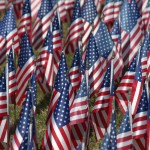 Americans are a people who have no problem speaking their minds. I suppose it all goes back to the reasons we left England in the first place. We were only allowed to believe certain things, and if we chose to be different, we could have been killed or imprisoned. It is what our nation was built on in more ways than just religion. The point was supposed to be that we were free to live our lives as we chose to, within a very few certain guidelines. For the most part, things went along smoothly…until November of 1860, when President Lincoln was elected to the presidency, that is. The people of the Deep South felt that their way of life was being threatened, in that they held slaves, and Lincoln was against slavery, as were the Northern states, or most of the people in the Northern states anyway. Of course, this whole issue brought our nation to war, a really sad thing when two sides of a nation war against each other.
Americans are a people who have no problem speaking their minds. I suppose it all goes back to the reasons we left England in the first place. We were only allowed to believe certain things, and if we chose to be different, we could have been killed or imprisoned. It is what our nation was built on in more ways than just religion. The point was supposed to be that we were free to live our lives as we chose to, within a very few certain guidelines. For the most part, things went along smoothly…until November of 1860, when President Lincoln was elected to the presidency, that is. The people of the Deep South felt that their way of life was being threatened, in that they held slaves, and Lincoln was against slavery, as were the Northern states, or most of the people in the Northern states anyway. Of course, this whole issue brought our nation to war, a really sad thing when two sides of a nation war against each other.
It is a difficult thing when so many people have such differing beliefs about the same issue. And sometimes it gets so ugly, that I have to wonder about the sanity of some people. When people burn or otherwise deface our flag, sometimes in horribly disgusting ways, or do the same to Bibles and other religious books, it is disrespectful. What I find especially disturbing is that these same people want respect for their cause or lifestyle, but they will not give the same respect for the cause or lifestyle of others. It really is a two way street. I know that a lot of people are calling for the removal of the Confederate Flag from…everywhere, but in reality it is a part of our history. We need to remember that because they lost the battle, it 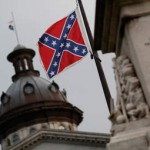 does not mean they were not brave in the fight. Lately, I have seen some shocking displays in this nation. Digging up the graves of a general and his wife, because he fought for the South, and taking shows off the air because they have a reference to a Confederate Flag in them. Political Correctness has tipped the balance of this nation to the point of insanity. It must stop, or we will have another war here. We have already had a threat of states wanting to secede from the union. It is a sad state for this great nation to be in.
does not mean they were not brave in the fight. Lately, I have seen some shocking displays in this nation. Digging up the graves of a general and his wife, because he fought for the South, and taking shows off the air because they have a reference to a Confederate Flag in them. Political Correctness has tipped the balance of this nation to the point of insanity. It must stop, or we will have another war here. We have already had a threat of states wanting to secede from the union. It is a sad state for this great nation to be in.
In the end of the Civil War, the South lost the war, the slaves were freed, and given their proper rights. No, it wasn’t the last of the battles over this issue, unfortunately, but the healing of this nation began. The eleven states that had seceded from the Union…Alabama, Florida, Georgia, Louisiana, Mississippi, South Carolina, Texas, Arkansas, North Carolina, Tennessee and Virginia, were returning one by one. Change was coming and it would slowly come to be accepted. I suppose that, as in the Civil War, the people who are fighting for their rights these days, consider the battles well worth the outcome, and maybe they are, but in many ways, we have forgotten that the people of the other side of the issue have rights too. The country was largely founded on a live and let live way of life…whether you agree with them or not. This may not be the perfect way for our nation to be, but it is as close as we can get. As with the eleven states who returned to the Union, I think it is important to consider the feeling of those who have lost the battle you felt the need to win, because in most cases, they are good people too. On this historic day, as our nation became united again, Georgia became the  last state to be readmitted to the Union. They returned, because whether they agreed with every thing this nation stood for or not, they still knew that this was a great nation, and one they wanted to be a part of. I believe that was the case of the Cowboys and Indians. We all know that the Indians lost to the cowboys, but that does not make them any less a proud people, nor does it make them any less brave. They deserve respect, as do all the people who have lost the battles that have gone on in this nation about political correctness, policy change, or the battle of the North and South. In the words of Abraham Lincoln, “A house divided against itself cannot stand.” Whether we agree with things or disagree, we must stand united…lest we forget that the rights we take from another today, could be taken from us tomorrow.
last state to be readmitted to the Union. They returned, because whether they agreed with every thing this nation stood for or not, they still knew that this was a great nation, and one they wanted to be a part of. I believe that was the case of the Cowboys and Indians. We all know that the Indians lost to the cowboys, but that does not make them any less a proud people, nor does it make them any less brave. They deserve respect, as do all the people who have lost the battles that have gone on in this nation about political correctness, policy change, or the battle of the North and South. In the words of Abraham Lincoln, “A house divided against itself cannot stand.” Whether we agree with things or disagree, we must stand united…lest we forget that the rights we take from another today, could be taken from us tomorrow.
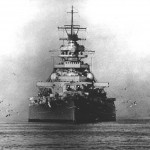 After I wrote the story about the sinking of the Bismarck, my nephew, Steve Spethman told me about a documentary he had about the man who located the Bismarck, and the search for it. Of course, I jumped at the chance to watch it, but when I was done watching it, I felt…different. It’s easy to be excited about a victory in a battle in wartime, or in a war that your dad fought in. It’s easy to set aside the thoughts of lives lost in historic battles, when you know that the battle had to be fought, and the victory would determine the course of the world stage. The problem with that thinking though, is that all too often…especially in countries governed by an evil dictator, such as Adolf Hitler, the people involved in the war, have no choice as to whether or not to fight. I know that a draft is sometimes necessary, but I would much rather have a military machine composed of volunteers than one from a draft. I think volunteers know what they are walking into. It is a cause they agree with, not one they were forced to accept.
After I wrote the story about the sinking of the Bismarck, my nephew, Steve Spethman told me about a documentary he had about the man who located the Bismarck, and the search for it. Of course, I jumped at the chance to watch it, but when I was done watching it, I felt…different. It’s easy to be excited about a victory in a battle in wartime, or in a war that your dad fought in. It’s easy to set aside the thoughts of lives lost in historic battles, when you know that the battle had to be fought, and the victory would determine the course of the world stage. The problem with that thinking though, is that all too often…especially in countries governed by an evil dictator, such as Adolf Hitler, the people involved in the war, have no choice as to whether or not to fight. I know that a draft is sometimes necessary, but I would much rather have a military machine composed of volunteers than one from a draft. I think volunteers know what they are walking into. It is a cause they agree with, not one they were forced to accept.
The movie about the Bismarck’s location, while mostly about the location of a sunken ship, was very different  from the documentaries I had seen about other ships, like the Titanic. While both ships were located by the same man, Robert Ballard, the feelings taken away from the Bismarck, both for Ballard and for the audience were quite different. The addition of commentary from some of the actual survivors of the Bismarck, as well as men on the ships who went in for the final sinking and the rescue of survivors, was very sobering. I was very moved by the German men who remembered the name of the man, Joe Brooks, who risked his own life to try to pull them from the water. They said, in fact, that his name was revered among German soldiers everywhere. This was a man who, in a war situation, chose to do good to his enemies…an almost unheard of act in wartime, but that act from the middle of a war, is still remembered 74 years later.
from the documentaries I had seen about other ships, like the Titanic. While both ships were located by the same man, Robert Ballard, the feelings taken away from the Bismarck, both for Ballard and for the audience were quite different. The addition of commentary from some of the actual survivors of the Bismarck, as well as men on the ships who went in for the final sinking and the rescue of survivors, was very sobering. I was very moved by the German men who remembered the name of the man, Joe Brooks, who risked his own life to try to pull them from the water. They said, in fact, that his name was revered among German soldiers everywhere. This was a man who, in a war situation, chose to do good to his enemies…an almost unheard of act in wartime, but that act from the middle of a war, is still remembered 74 years later.
So seldom, when talking about a war, do you hear about both sides of the war. While you may hear about 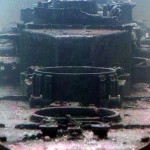 their goals and reasons for going to war, you don’t hear about the human factor of each side. I think that was the thing that made me feel so different…almost somber after the movie. One man said that in a sea battle, you usually never see the enemy. He saw men…just briefly as they were running across the deck of the Bismarck. That was it…until they were in the water beside his ship. Then they weren’t soldiers, but real people in dire straits, who were about to lose their lives. In the end, Robert Ballard stood alone at the back of the ship he was on when he found the Bismarck, and I could tell that he felt the same way as I did. The war and the battle had both been a necessary action on the part of the allies, because evil cannot be allowed to prevail, but that simply does not change the fact that these were real lives and real tragic situations.
their goals and reasons for going to war, you don’t hear about the human factor of each side. I think that was the thing that made me feel so different…almost somber after the movie. One man said that in a sea battle, you usually never see the enemy. He saw men…just briefly as they were running across the deck of the Bismarck. That was it…until they were in the water beside his ship. Then they weren’t soldiers, but real people in dire straits, who were about to lose their lives. In the end, Robert Ballard stood alone at the back of the ship he was on when he found the Bismarck, and I could tell that he felt the same way as I did. The war and the battle had both been a necessary action on the part of the allies, because evil cannot be allowed to prevail, but that simply does not change the fact that these were real lives and real tragic situations.
 When I first read about the six Knox brothers who were able to place themselves into a family history where they belonged, but in which no one had been able to connect them to before, I was intrigued, for sure. They seemed so resourceful, but I had a feeling that there was a lot more to them than just finding their place in the family history. I’m sure I will come back to these brothers over and over in the future, but when I read about Dr Nicholas C Knox, I was…well, amazed really. This man had the character and fortitude to overcome adversity, and move forward with his life, and in the end, make it better.
When I first read about the six Knox brothers who were able to place themselves into a family history where they belonged, but in which no one had been able to connect them to before, I was intrigued, for sure. They seemed so resourceful, but I had a feeling that there was a lot more to them than just finding their place in the family history. I’m sure I will come back to these brothers over and over in the future, but when I read about Dr Nicholas C Knox, I was…well, amazed really. This man had the character and fortitude to overcome adversity, and move forward with his life, and in the end, make it better.
The fourth son of Absalom Knox MD, Nicholas married Henrietta Craigan. After their marriage, the civil war slammed its way into the midst of their lives. Nicholas enlisted in the Seventeenth Mississippi Regiment, which was commanded by Colonel WS Featherstone, and was a part of McLaw’s Division. Nicholas took part in all the great battles in the Army of Virginia in which his command was engaged, but it was the Battle of Gettysburg that would change his life forever. On the second day of the battle, Nicholas lost his right arm. To make matter worse, he was captured and confined as a prisoner on Hart Island, off the city of New York, for several months before being parolled and sent into the Confederate lines again…without his right arm, and he managed to stay alive during the remainder of the battles he fought in.
During his entire enlistment time in the Civil War, Nicholas was never home…until the day he was discharged. I don’t know if he had been able to tell his wife about his arm, but even if he did, there is nothing like actually seeing it for the first time. It had to be hard for her…and for him. Many soldiers coming home from wars with life changing injuries feel very concerned about just how their spouse will look at them now. They feel like they are a lesser person than they were when they left, and that is just the physical challenges. I’m sure that an injury that cost you your arm, would be a moment that would live in your memory files for the rest of your life.
Nevertheless, Nicholas was not a man to let adversity take his life or his future from him. He returned to Mississippi, and he started the task of rebuilding his life, and getting reacquainted with his family. He started out by teaching school. Now most people would think that was a noble profession, and they would be right, but 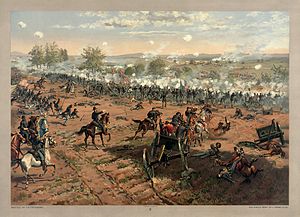 it was not enough for Nicholas. While teaching school, he began to study medicine, and received a diploma from a medical college at Nashville, Tennessee. When I think about the challenges of being a doctor in post Civil War America, with only one arm, and during a time when prosthetics were primitive at best, I am amazed. Still, Nicholas was not satisfied. He entered politics, and represented his county in the Legislature, and afterward was a practitioner of medicine in Reynolds, Mississippi, and he was an elder in the Presbyterian Church. No matter what challenges hit Nicholas, he met them head on, and succeeded in every endeavor he took on. He was not a man content to settle on the ordinary. He was truly an amazing man.
it was not enough for Nicholas. While teaching school, he began to study medicine, and received a diploma from a medical college at Nashville, Tennessee. When I think about the challenges of being a doctor in post Civil War America, with only one arm, and during a time when prosthetics were primitive at best, I am amazed. Still, Nicholas was not satisfied. He entered politics, and represented his county in the Legislature, and afterward was a practitioner of medicine in Reynolds, Mississippi, and he was an elder in the Presbyterian Church. No matter what challenges hit Nicholas, he met them head on, and succeeded in every endeavor he took on. He was not a man content to settle on the ordinary. He was truly an amazing man.
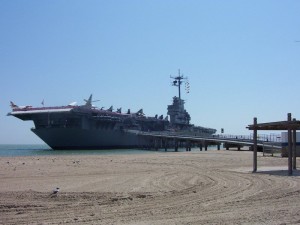
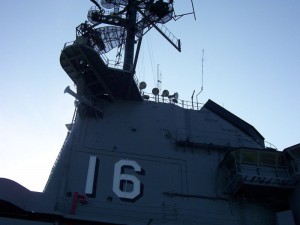 While Bob and I were in Texas on vacation in April of 2006, we had the wonderful opportunity to visit the USS Lexington…The Blue Ghost. This ship has a long and interesting history, and one I didn’t really know all that much about when I visited the ship. The ship we saw is not the original USS Lexington, but rather the one that replaced the original. The USS Lexington that we saw has an amazing history too…it is, in fact, a legend that was named for the American Revolution’s Battle of Lexington. On December 5, 1941, the original USS Lexington, which was one of the two largest aircraft carriers the United States had during World War II, was making its way across the Pacific in order to carry a squadron of dive bombers to defend Midway Island from an anticipated Japanese attack. The attack they anticipated did occur, but not where it had been expected. The attack was lodged on Pearl Harbor instead. The USS Lexington turned around and headed for Pearl Harbor, arriving on December 13th. That Lexington was later sunk.
While Bob and I were in Texas on vacation in April of 2006, we had the wonderful opportunity to visit the USS Lexington…The Blue Ghost. This ship has a long and interesting history, and one I didn’t really know all that much about when I visited the ship. The ship we saw is not the original USS Lexington, but rather the one that replaced the original. The USS Lexington that we saw has an amazing history too…it is, in fact, a legend that was named for the American Revolution’s Battle of Lexington. On December 5, 1941, the original USS Lexington, which was one of the two largest aircraft carriers the United States had during World War II, was making its way across the Pacific in order to carry a squadron of dive bombers to defend Midway Island from an anticipated Japanese attack. The attack they anticipated did occur, but not where it had been expected. The attack was lodged on Pearl Harbor instead. The USS Lexington turned around and headed for Pearl Harbor, arriving on December 13th. That Lexington was later sunk.
In early May, the first USS Lexington returned to the South Pacific to assist the USS Yorktown to fight against the Japanese offensive in the Coral Sea. On May 7th and 8th of 1942 planes from the USS Lexington helped sink the small Japanese aircraft carrier Shoho and participated in attacks on the large carriers Shokaku and Zuikaku. But, she was a major target of Japanese carrier planes and received two torpedo and three bomb hits. Initially, it appeared that the damage control efforts were successful, but she was racked by gasoline explosions early on the afternoon of May 8th. The fires were out of control, and it was clear that the Lexington was breathing her last breath. The ship was abandoned by her crew and it sunk. It was the first US aircraft carrier to be lost in World War II.
The second Lexington began its journey into fame on February 17, 1943, and it would serve longer and set more records than any other carrier in US Naval history. Originally to be named the Cabot, the name was changed after the sinking of the original Lexington in the Coral Sea. The Lexington became a part of the Fifth Fleet at Pearl Harbor. The ship took part in nearly every major operation in the Pacific Theater, serving 21 months in combat. It was here that the Lexington became famous in her own right. The Japanese radio station, the Tokyo Rose was always spreading rumors and propaganda. The station declared the Lexington sunk at least four times, but was proven wrong at the next battle, when the Lexington returned to the fight. I guess it must have been in an effort to save face that the Tokyo Rose dubbed the Lexington The Blue Ghost, indicating that it was a ghost ship returning to haunt the Japanese again and again. All the hard work paid off in the end though. The Lexington participated in the Great Marianas Turkey Shoot, the Battle of Leyte Gulf, and the Battle of the Philippine Sea. She received the Presidential Unit Citation and 11 Battle Stars during her service in World War II, and she was the first battleship into Tokyo Harbor for the Japanese peace treaty signing.
By the time we visited the second USS Lexington, she had been a museum since October of 1992. The ship had been decommissioned in August of 1990, after serving as a training ship for naval aviators in Pensacola, Florida since 1962. She was moved to her permanent location in Corpus Christi, Texas in January of 1992. We had the wonderful opportunity to explore the ship to our hearts’ content while we were there. It was quite interesting to us. I didn’t know much about how things were on a ship, but I found myself amazed over and over again. The way the crew lived, seemed so archaic to me, but I suppose that anyone who has ever served on a ship would tell me that it was all very normal. Finding your way around seemed so difficult to me, and I know we would have been lost repeatedly, had they not marked the directions with arrows on the floor and walls. It was hard to imagine just what being on board this ship in the midst of a battle must have felt. I don’t think anyone goes to war without a measure of fear. Nevertheless, there was no going back for the men, and later, women who 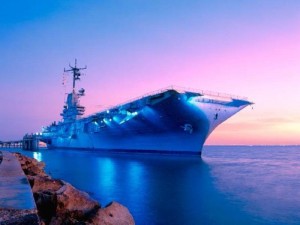
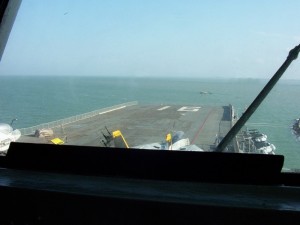 served on the Lexington. The Lexington was the first aircraft carrier to have women stationed on board. These men and women served courageously and honorably, some giving their lives on the Lexington fighting the battles that were laid out before her. Knowing the history of this great ship leaves me with an entirely new perspective about what an awesome ship it was, and it makes me glad I had the opportunity to tour the USS Lexington.
served on the Lexington. The Lexington was the first aircraft carrier to have women stationed on board. These men and women served courageously and honorably, some giving their lives on the Lexington fighting the battles that were laid out before her. Knowing the history of this great ship leaves me with an entirely new perspective about what an awesome ship it was, and it makes me glad I had the opportunity to tour the USS Lexington.

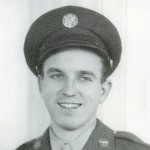 Every soldier who ever signed up had to go through a few moments of fear or worry about where the steps they were taking were going to lead them. Whether they signed up voluntarily, or were drafted, there was always the possibility, or in many cases, the probability that they would soon find themselves fighting and killing men, or boys really, who were the same age or even younger than they were. In early wars, the fighting was hand to hand, and even when guns were invented, they often saw the result of their direct hit on the enemy. They witnessed the fear, so vividly evident on the face of that person who was the enemy, and yet was really no different than they were. Both men were scared. It truly was kill or be killed, because it was war, and the only objective was to win.
Every soldier who ever signed up had to go through a few moments of fear or worry about where the steps they were taking were going to lead them. Whether they signed up voluntarily, or were drafted, there was always the possibility, or in many cases, the probability that they would soon find themselves fighting and killing men, or boys really, who were the same age or even younger than they were. In early wars, the fighting was hand to hand, and even when guns were invented, they often saw the result of their direct hit on the enemy. They witnessed the fear, so vividly evident on the face of that person who was the enemy, and yet was really no different than they were. Both men were scared. It truly was kill or be killed, because it was war, and the only objective was to win.
Many of my ancestors have been in wars, including most recently, my dad, brothers-in-law, several uncles, nephews, and grandfathers. I have read some of my dad’s letters home from the war, and while he tried to sound positive and unafraid, you could still see, if you read between the lines, that war and a degree of fear simply went together. Still, I can imagine that as each of those men and women are standing in line to get the many vaccinations they had to have, that for a least a moment, they wondered just what they had gotten themselves into. Of course, there was really no way out. It didn’t matter if they enlisted voluntarily or were drafted, they belonged to Uncle Sam either way. They were going into battle, and that’s all there is too it.
Of course, the soldier is trained to be brave and not to show fear, and maybe they truly have to do that. I know that if you show fear to a dog, they pick up on that…so does the enemy too…maybe. All I know is that deep in their hearts, they must feel like they would like to run in the face of enemy fire. Of course, they can’t. They must fight. This is war…this is kill or be killed…this is their duty, and even if it means that they lose their life, they must do their duty. People are depending on them. Not just their platoon members, but their nation, and the people of the nation they are trying to protect from whatever evil people are trying to take them over.
When I think of our soldiers, I have to think of how very brave and courageous they are, 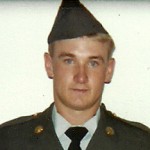
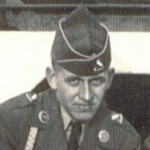 because as the saying goes, “I learned that courage was not the absence of fear, but the triumph over it. The brave man is not he who does not feel afraid, but he who conquers that fear.” I feel very proud of all those men and women in our family, as well as our friends, who have answered the call to duty, set aside their fears, and gone out to do their duty in the fight against evil. They are a huge part of what makes this country great.
because as the saying goes, “I learned that courage was not the absence of fear, but the triumph over it. The brave man is not he who does not feel afraid, but he who conquers that fear.” I feel very proud of all those men and women in our family, as well as our friends, who have answered the call to duty, set aside their fears, and gone out to do their duty in the fight against evil. They are a huge part of what makes this country great.
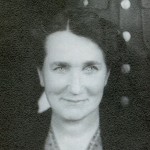 As time marched forward toward the United States entering World War II, many people were afraid for the lives of their sons. My dad’s mother, who had two sons, was among them. Things were really heating up while my dad was working in California, and the family really wanted him come home. The word was that any young men 18 to 20 years of age were going to be deployed by Christmas 1942, putting my dad and my Uncle Bill squarely in that group. It was a fearful time in our country. People didn’t want their sons to go to the war, but they knew that Hitler had to be stopped. The things Hitler was doing were so horrible that everyone knew that he must not be allowed to take any more countries over. He was completely insane and dead set on controlling the whole world. They knew that while the fear of sending their sons into battle was almost more than they could possibly bear, it was also going to be the only way to stop this horrible man.
As time marched forward toward the United States entering World War II, many people were afraid for the lives of their sons. My dad’s mother, who had two sons, was among them. Things were really heating up while my dad was working in California, and the family really wanted him come home. The word was that any young men 18 to 20 years of age were going to be deployed by Christmas 1942, putting my dad and my Uncle Bill squarely in that group. It was a fearful time in our country. People didn’t want their sons to go to the war, but they knew that Hitler had to be stopped. The things Hitler was doing were so horrible that everyone knew that he must not be allowed to take any more countries over. He was completely insane and dead set on controlling the whole world. They knew that while the fear of sending their sons into battle was almost more than they could possibly bear, it was also going to be the only way to stop this horrible man.
The letters from home to my dad in California were filled with worried questions. They had heard rumors of the impending deployment back home in Holyoke, Minnesota, and were desperately hoping that what they heard in that small town was wrong. They questioned my dad, as to why he thought he would be going so soon. Uncle Bill and Dad had both decided  that if one was called to go, the other would join up too. I’m sure they were thinking that if they went together, they could watch each other’s back. In the end, that was not to be, because Uncle Bill had flat feet and a hernia that needed to be repaired. It was a devastating blow to him. He wanted so desperately to be there with his little brother. He had always been there for him, to protect him, and it seemed impossible that he couldn’t do that this time. He was scared for his little brother. He even tried to get him to take welding classes, because he mistakenly thought that my dad wouldn’t have to go if he was working in the shipyards. I don’t know if dad took the classes or not…he did at some point, because he worked as a welder for many years…but if he did, it did no good, because they needed men in the war zones, and that was more important to the country. In the end, he chose the Army Air Force, and went to the war, did his duty to his country and the world, and he lived!!
that if one was called to go, the other would join up too. I’m sure they were thinking that if they went together, they could watch each other’s back. In the end, that was not to be, because Uncle Bill had flat feet and a hernia that needed to be repaired. It was a devastating blow to him. He wanted so desperately to be there with his little brother. He had always been there for him, to protect him, and it seemed impossible that he couldn’t do that this time. He was scared for his little brother. He even tried to get him to take welding classes, because he mistakenly thought that my dad wouldn’t have to go if he was working in the shipyards. I don’t know if dad took the classes or not…he did at some point, because he worked as a welder for many years…but if he did, it did no good, because they needed men in the war zones, and that was more important to the country. In the end, he chose the Army Air Force, and went to the war, did his duty to his country and the world, and he lived!!
For some time now, I thought that the main reason my dad’s letters home were always upbeat and positive was so that he could protect his mother…keep her from worrying about how bad things were. Now, after reading her letters to him, and the letters from his brother and sisters, talking about how worried their mother was, I realized that he wasn’t trying to keep her from worrying…she had already voiced those fears…she was already in the middle of serious worry, and now she was in the middle of praying that her boys wouldn’t have to go, and if they did…please dear Lord, take care of them and bring them home to her!!
It is hard enough to go into battle or to send your son into battle…to deal with the fear in your own heart…much less to know that your soldier was scared…and for the soldier, to know that  your family is scared. Knowing my dad like I do, I know that he was in the process of pushing his fear back, putting his faith in God, and setting his mother’s worried mind at ease. He knew he could not stop what was coming, but the hardest thing to accept was that he couldn’t really stop his mother’s fears…no matter how excited, positive, or fearless he made his letters sound. And, that tore him up more than anything he would face in the war. The days leading up to, and during World War II, were filled with the worries and fears of a nation. The letters to the soldiers and home from the war, were carefully worded so as to try to alleviate the fears that could not be alleviated until the deployed loved ones were home again.
your family is scared. Knowing my dad like I do, I know that he was in the process of pushing his fear back, putting his faith in God, and setting his mother’s worried mind at ease. He knew he could not stop what was coming, but the hardest thing to accept was that he couldn’t really stop his mother’s fears…no matter how excited, positive, or fearless he made his letters sound. And, that tore him up more than anything he would face in the war. The days leading up to, and during World War II, were filled with the worries and fears of a nation. The letters to the soldiers and home from the war, were carefully worded so as to try to alleviate the fears that could not be alleviated until the deployed loved ones were home again.
 Easton is like most little boys. He hates the whole dressing up thing that many parents are always wanting their kids to do. In fact, if he could figure out a way to get out of ever dressing up, he would do it. I think most men would have a tendency to agree with Easton…especially when it comes to wearing a tie. They just hate that tie. It chokes them, and if they are at all claustrophobic, it can make them feel like the walls are closing in. And for a little boy, it is even worse. I suppose it could be likened to sitting in a corner, or time out. In fact, time out probably says it all, because just as soon as they dare, little boys are asking, “Can I please take this tie off??” That is, if they ask to take it off at all.
Easton is like most little boys. He hates the whole dressing up thing that many parents are always wanting their kids to do. In fact, if he could figure out a way to get out of ever dressing up, he would do it. I think most men would have a tendency to agree with Easton…especially when it comes to wearing a tie. They just hate that tie. It chokes them, and if they are at all claustrophobic, it can make them feel like the walls are closing in. And for a little boy, it is even worse. I suppose it could be likened to sitting in a corner, or time out. In fact, time out probably says it all, because just as soon as they dare, little boys are asking, “Can I please take this tie off??” That is, if they ask to take it off at all.
Easton had finally had enough, and so he untucked his shirt and loosened his tie. He hoped that his mom wouldn’t notice, and in the end, his hopes were realized. His mom, my niece, Machelle took the picture without even noticing the tie was loosened and the shirt untucked. It was Easton’s Aunt Susan who would notice the sneaky maneuver her nephew had pulled off. By that time, there was nothing left to do but laugh at the fact the Easton had won…that battle anyway.
Now, if you were to put Easton, and most other little boys, in a different situation, you would find that they are totally comfortable. That situation would be, of course, camping. There is nothing better, in the mind of a little boy, than the adventures you can  have while camping in the wilderness. All sorts of things can happen out there, and everyone will need a hero to save them from whatever danger might lurk just outside of the eye view of the camp. There could be wolves, bears, snakes, and many other such wild animals, but their moms can relax, because these boys will save them from that. They are big tough campers, and everyone knows that any self respecting wolf or bear, or even snake, would run from them. And that is the main reason why moms must understand that real boys, hate that tie. They are simply too macho for their tie!!
have while camping in the wilderness. All sorts of things can happen out there, and everyone will need a hero to save them from whatever danger might lurk just outside of the eye view of the camp. There could be wolves, bears, snakes, and many other such wild animals, but their moms can relax, because these boys will save them from that. They are big tough campers, and everyone knows that any self respecting wolf or bear, or even snake, would run from them. And that is the main reason why moms must understand that real boys, hate that tie. They are simply too macho for their tie!!
Today is Easton’s 9th birthday. Easton, I hope you don’t have to wear that horrible tie!! I mean, really Machelle, get a clue!! Real boys are too macho for a tie!! Happy birthday Easton!! Have a great, tieless day!! We love you!!

